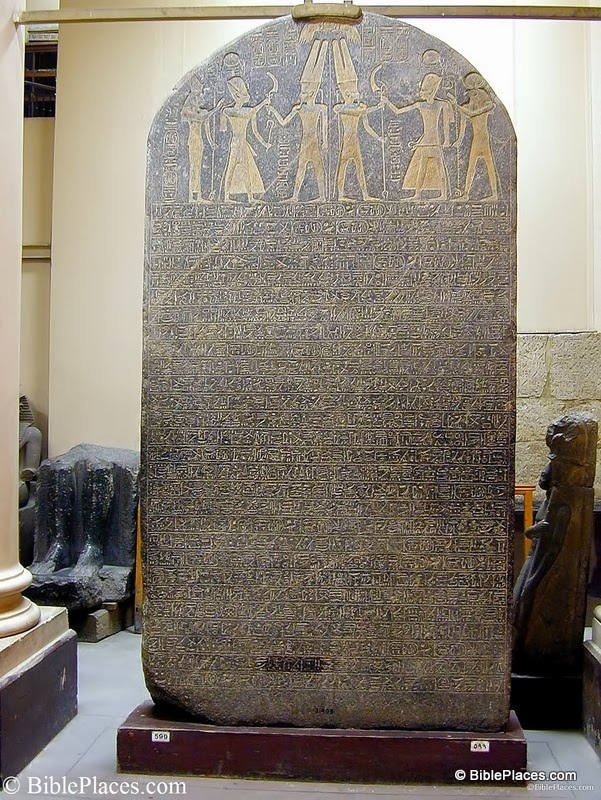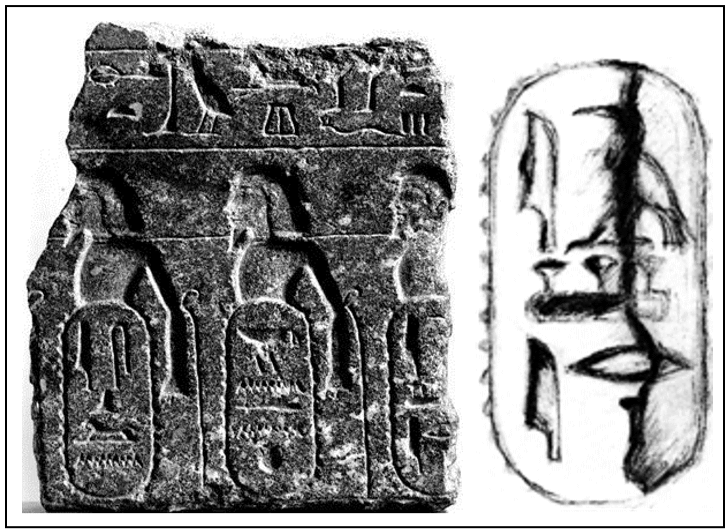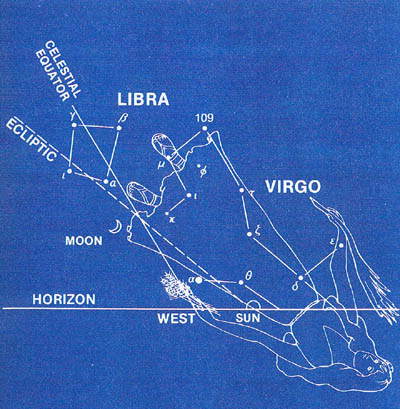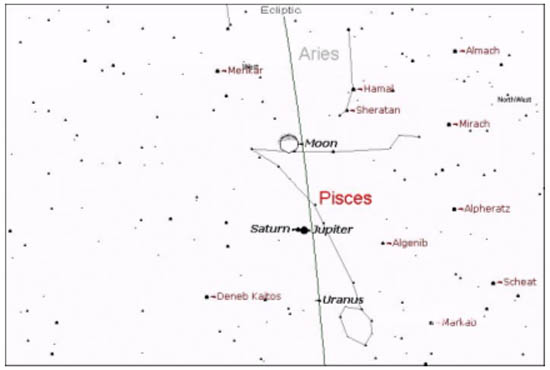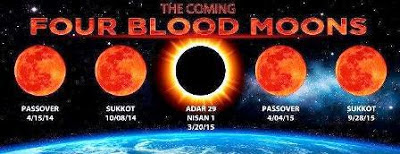
The current Four Blood Moons of 2021-22 have not gotten the media attention that its predecessors have, most likely due to a technicality. Blood Moon Tetrads are recognized as four Total Lunar Eclipses in a row, but the Nov. 21st , 2021′ Lunar Eclipse
was not total, just missing with only 97% of the lunar surface covered in Earth’s shadow. This makes it a partial Lunar eclipse and technically rules out being classified as a Blood Moon Tetrad. For this reason, it may sneak up on people as opposed to the Tetrads of 1949-50, 1967-68, and the most recent of 2014-2015, seen in the title banner above. This however, does not mean it should be ignored, as there are notable signs on Jewish Holidays surrounding them!
As we approach the end of the recent Blood Moon Quartet of 2021-22, the focus of this blog will be how these current Blood Moons relate to the previous tetrad in 2014-15 with the signs of 2016-17. To understand this, we must be aware what is known on the Hebrew Calander as the Shemita Cycle. The Shemita cycle includes both a Shemita Year and Week cycle which is a 7-year Sabbath release, where there was rest for the land with no sowing or reaping in the 7th year, and financial slates were wiped clean, with debts forgiven and real estate reverting to the original owners, [Levi. 25:1-7].
In Levi. 25:8-9 God spoke to Moses with “thou shalt number seven sabbaths of years, and seven times seven years; and the space of seven sabbaths of years shall be unto thee forty and nine years. 9 Thou shalt cause the trumpet of Jubilee to sound on the tenth day of the seventh month, in the day of Atonement, shall ye make the trumpet sound throughout all your land. [see Levi. 25:10-13]
It is key to realize that these seven-year cycles of Shemita years are related to both the Feast of Trumpets announcing the Jubilee on the Day of Atonement, concluding the sabbath year, as it did when Jesus was crucified in 27-28AD. A Shemita cycle would be one of the seven-year periods in the “seven sabbaths of years” that leads to the 49 years,” culminating in the 50-year Jubilee. Not only this, but even at the start of the Lord’s Earthly Ministry in Luke 4:18-19, he preached to them in the Acceptable year of the Lord, referencing that Jesus‘ laying down his life, was divinely approved by the Heavenly Father-Who anointed Jesus at this particular time and only by his sacrifice, to redeem mankind. Dr. Earnest Martin points out the links between the Acceptable Year of the Lord and Sabbatical years related to Luke 4:18-19 as follows. When Jesus announced that he was anointed to preach the Gospel to the poor, it was “a reflection of Sabbatical regulations that the poor and the stranger could eat from the fields without hinder.” 1
It is no coincidence that the Jubilee refers to these specifics in [Levi 25:10], as the 50th year was hallowed, and liberty was proclaimed throughout all the land unto all the inhabitants thereof. God sent Jesus to heal the broken-hearted, to preach deliverance to the captives, and the recovery of sight to the blind, to set at liberty them that are bruised. “This recalls the Sabbatical release laws and being free from debt as stated in Deut. 15: 1-6.” The Lord’s Release here was certainly fulfilled by Jesus as the Passover Lamb. This Acceptable Year is the kind of release Sabbath referred to in Isa. 58:6, which Jesus proclaimed at the Synagogue in Nazareth that always began on the Day of Atonement. The end of this Sabbatical year and seven-year Shemita cycle on the Day of Atonement in Tishri, ties not only to the birth of Christ on Tishri 1, 3 BC but also the cycle of regnal years from Tishri 1 to Tishri 1 for Kings in Israel and Judah, for the Priest-King of Israel and Lion of Judah, who also fulfilled the requirement of the Lamb of the first year. As a result, Jesus’ ministry could not have been longer than two years, as opposed to the 3.5 years many hold. Dr. Martin points out the influence of the Prophet Daniel on the Sabbatical Cycle as follows;
“These early opinions on the symbolic teaching of Sabbatical years were no doubt prompted by the Sabbatical periods recorded by Daniel. His 70 weeks Prophecy was an extension of the Sabbatical year’s theme, and this prophecy was the prime reference point for the Advent of the Messianic Age, that the Jews were expecting in the first Century.”2 Here are the verses detailing Daniel’s 70 weeks prophecy;
Dan. 9:24-27
24 “Seventy weeks are determined concerning thy people and concerning thy holy city to finish the transgression and to make an end of sins, and to make reconciliation for iniquity, and to bring in everlasting righteousness, and to seal up the vision and prophecy, and to anoint the Most Holy. 25 Know therefore and understand that from the going forth of the commandment to restore and to build Jerusalem until the Messiah the Prince, shall be seven weeks and threescore and two weeks; the street shall be built again, and the wall, even in troublesome times. 26 And after threescore and two weeks shall Messiah be cut off, but not for Himself; and the people of the prince who shall come shall destroy the city and the sanctuary. And the end thereof shall be with a flood, and until the end of the war, desolations are determined. 27 And he shall confirm the covenant with many for one week; and in the midst of the week he shall cause the sacrifice and the oblation to cease. And for the overspreading of abominations he shall make it desolate, even until the consummation, and that determined shall be poured upon the desolate.”
Rev. Jon Nessle teaches how this relates to Daniel’s prophecy… of the princes;
“The first use of the word, prince, [9:25] obviously is referring to the Messiah. However, the second cannot. How could the genuine Messiah destroy the city and sanctuary? So there must be two different princes in this context. Just like verses 25 and 26 speak of each, verse 27 alternates between the two. Jesus, the Messiah confirmed the covenant during holy week by becoming our Passover. When he was raised from among the dead, the covenant was sealed and the restitution of all things made inevitable. In the midst of that week, on a Wednesday, Messiah caused the sacrifice and oblation to cease. When he died, the veil of the Temple tore in two from top to bottom, clearing the way into the holy of holies without any more sacrifices or offerings, because the supreme one had occurred. The other prince was Titus the future Emperor of Rome, and his army desecrated the Temple with their abominations, so just as Antiochus IV was a type of the Anti-Christ, so also was Titus. Thus a first Century occurrence of Daniel’s prophecy is plausible.” 3
Many students of this prophecy have acknowledged that the prince who causes the Abomination that makes desolate refers to the future Anti-Christ of the Great Tribulation, but most have not considered the historical figures of Antiochus IV or Titus of Rome, as forerunners of this Anti-Christ. The link above on Antiochus IV has a blog connecting a Blood Moon Tetrad with Antiochus‘ desecration of the Jerusalem Temple in 168-166 BC, just before the 1st Hannukah. History attests to the significance of the Shemita Cycle, as Nebuchadnezzar destroyed the Jews Temple in 586 BC in the 1st year of a Shemita Cycle, as did the Romans under Titus in 70 AD, both on the 9th of AV.

Luke 4:18-19 also reflects how Jesus quoted the text from Isa. 61:1-2, stopping at the Acceptable year of the Lord, making sure not to include “the Day of Vengence of our God,” which was and remains a future event. This Day of Vengence refers to our God, Who is the avenger and Judge, and Christ who treads the winepress of God’s wrath, as he treads the evil down in anger, whose blood will be sprinkled on his garments, [Isa. 63:1-4]. The wrath of God’s judgment is part of the Great Tribulation, which is preceded by the Age of Grace, arising by Christ’s ministry and proclamation of the Kingdom and King being rejected by Israel, resulting in the sacrifice of his crucifixion on Passover Wednesday, the 14th of Nisan in 28 AD, 30 years from 3 BC, followed by this nearly 2000-year period, including the Great and many Mysteries of the Church Age.
According to Mark Biltz, Jesus was crucified at the end of a Shemita week in Dan. 9:24-26, the 62+7 weeks=69 weeks leaving one week still to be fulfilled in Daniel’s 70-week Prophecy, or the last “week” of the 7-year Tribulation. As Daniel was a Jew who upheld the dictates of the Judean calendar, and Jesus’ crucifixion was at the end of a Shemita Cycle, so the Great Tribulation would begin when a Shemita cycle left off in Dan. 9:25-26, to start a new Shemita cycle. This also falls on Rosh Hashanah-New Year’s Day. 4 Ten Shemita’s cover a 70-year period and 7 Shemita cycles equal 49 years, with the 50th year being a Jubilee, that was also the 1st year of the next 7-year cycle. 50 years ago a new Shemita cycle began, aligned with Yom Kippur and the Day of Atonement in 73-74′. Since Jubilee years are only declared on the Day of Atonement at Yom Kippur, the 6-day war in 1967 also started a Shemita cycle with a Blood Moon Tetrad in 1967-68‘, even as the Yom Kippur War also began the first year of a Shemita cycle in 1973‘.
Yom Kippur in 2015 was exactly 2,520 weeks from June 7, 1967 when Israel won back the Temple Mount, during the Blood Moon Tetrad of 1967-68. However, in counting these days, Yom Kippur 2015-16 was the first year of a Shemita Cycle that also fell 700 days before Elul 1, 2017, and the Season of Repentance. Another total eclipse on March 9, 2016, is linked to the signs of the 2014-15 Blood Moon Tetrad, in the first year of a Shemita Cycle, completing 7 years later in 2021-22.
The Day of Atonement, “Yom Kippur” is the holiest day of the Hebrew year, and provides prophetic insight into the Second Coming of Jesus Christ our Messiah, the restoration of national Israel, and the final judgment of the world. The Day of Atonement alludes to the two great atonements given by the LORD – the first for the Gentiles among the nations who turn to Yeshua (Jesus) for cleansing and forgiveness, and the second for the purification of ethnic Israel during the great Day of the LORD at the end of days. (Rev. 6:15-9:21 & 11:15-19) “What Shall We Do?” Acts 2:36-47 Jn. 6:26-29, 10:22-33 Rom. 6, 7, & 8, Rev. 1:1-3. 5
Now in 2022-23′ we find ourselves opening another new 7-year Shemita Cycle. Since this year of 2022 wraps up the last Shemita Cycle, it is potentially pivotal as 22-23′ starts a new cycle. According to Mark Biltz-this Fall, the Nov. 8th, 2022 Blood Moon could begin the Tribulation week because it opens a new Shemita Cycle, that would pick up where the Crucifixion of Christ left off-at the end of a Shemita cycle in 28 AD. For this reason, if the current Shemita does not start the Tribulation week, it won’t start the Tribulation until the next Shemita Cycle in the fall of 2029-30′, [5790]. As Jubilee years can only fall on the [7th year of a Shemita Cycle], these Jubilee years are also always divisible in whole numbers of their Hebrew calendar number–by 49, and thus easy to identify. Biltz holds that every Rosh Hashanah, as Sept. 26th, 2022, including next month is thus
a candidate for the Lord’s Resurrection/Rapture event. He tells us that this event will align with the Day of Trumpets on the Hebrew Calendar, we just don’t know which year it will fall. When it does come however, it will activate the Gathering of the Church of the spiritual Body of Christ as we are raised to meet the Lord in the air, before the Great Tribulation and the revealing of the Anti-Christ. 6 [1 Cor. 15:50-53, 1 Thess. 4:13-18, 2 Thess. 1-14]
The Feast of Trumpets “Rosh Hashanah” is known in Israel as “the day no one knows the day or the hour,” because the feast day begins, once a New Moon is sighted and that information is relayed. The Feast of Trumpets is actually a 2-day feast, and no one really knows “the day or the hour,” until it happens and they learn about it. There is biblical evidence the “gathering together” will take place on the Feast of Trumpets some year, “with the trumpet call of God.” (1 Thes. 4:16, 1 Cor. 15:50-53, Matt. 24: 30-31, Rev. 7:9-14) 7
April 15th, 2014 opening Blood Moon of the 2014-2015 Tetrad, near Mars in Virgo.
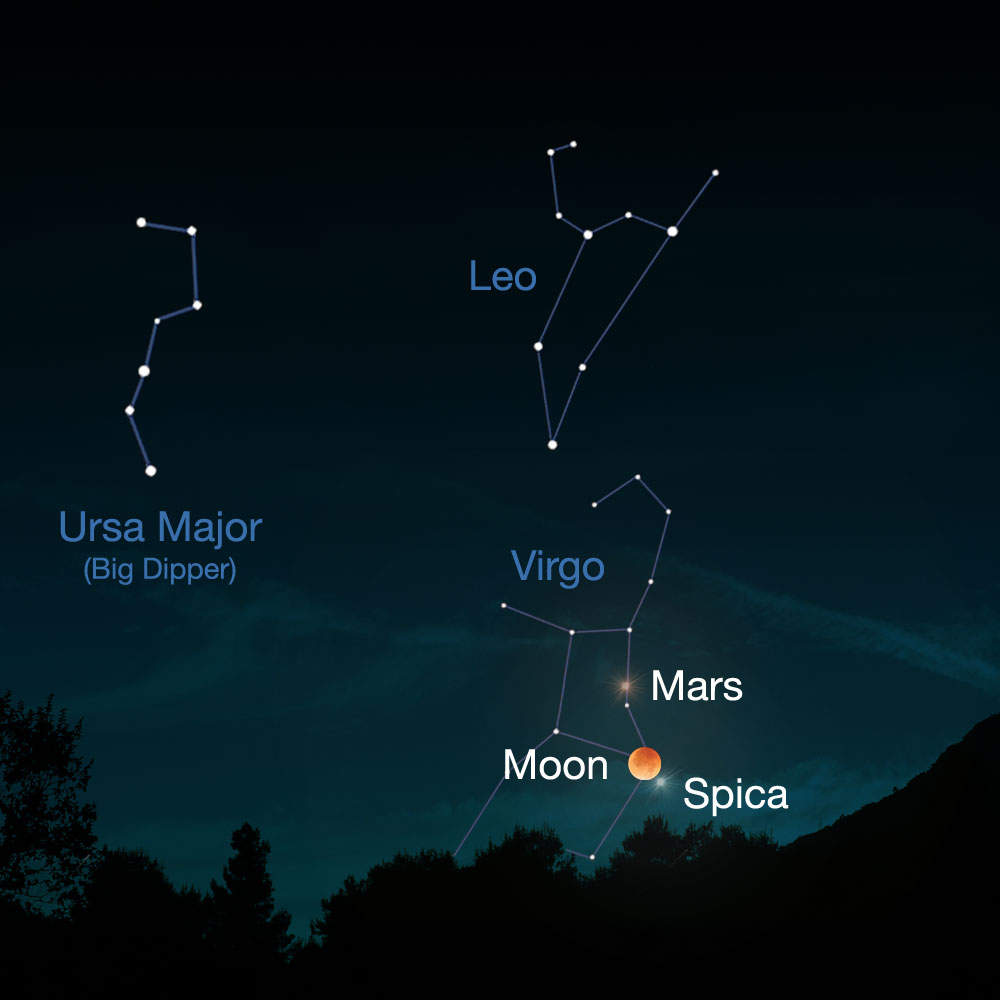
The recent history of Isreal and the Blood Moon Tetrads when modern Israel was formed as a nation-state, were marked by the Blood Moon Tetrad of 1949-1950, as an initial key. This was highlighted by a triple conjunction of Mars-Spica in Virgo to open the 2014-15 Blood Moon Tetrad. What is fascinating is that Mars in retrograde not only marks the 2014-2015 Tetrad, but also the previous two Blood Moon Tetrads in 1949-50 and 1967-68! Added to this, the triple planetary conjunctions linked with Mars’ retrograde, also mark all three sets of modern Blood Moon Tetrads according to the pattern of the Celestial Sphinx, with these planetary conjunction signs in both the Alpha-Omega signs of the Mazzaroth, Virgo and Leo.
The 2014 Passover Blood Moon initiated a Blood Moon Tetrad, concluding in Israel’s Jubilee Year of 2015, as a summation of 7 Sabbatical cycles in the 50th year. According to NASA, Mars which was a week past its closest point to the Earth; [opposition] was 9 degrees NW of the Blood Moon in Virgo, very close to the celestial scene also in Virgo, on 4/13/1968. As the Red Planet Mars was bright in the sky, it rivaled the Blood Moon in Virgo, and considering Mars’ symbolism in Biblical Astronomy, this gets even more interesting. In Bible Astronomy, Mars can embody Michael the Warrior Archangel fighting for God’s people, as we find Mars here coming to Israel’s [Virgo] aid in time of crisis or war. However, the Red Planet–Mars can also symbolize the sinless blood of Christ our Redeemer, who paid the incalculable price to save us from our sin. Throughout the OT, God Almighty used Israel as an example of His Power, Grace and Love as He delivered them from their enemies. We saw this in recent history of the Blood Moon Tetrads with 1949-50 and 1967-68, in Israel’s battles for statehood, and as they regained control of Jerusalem for the first time in nearly 2000 years, in fulfillment of prophecy.

We will now consider the current Blood Moon Quartet of 2021-22 consisting of the following Solar and Lunar Eclipses;
1. May 26th, 2021 Super Blood Moon Total Lunar Eclipse-Sivan 15 [May 16th-18 Shavuot].
This Total Lunar Eclipse started at 4:47:39 a.m. EDT (08:47:39 GMT), according to NASA’s Eclipse Page(opens in new tab). That’s when the moon touched the penumbra. The partial phase of the eclipse started about 57 minutes later, at 5:44 a.m. EDT (09:44:57 GMT). The moon entered the total phase of the eclipse at 7:11:25 EDT (11:11:25 GMT) and completed exiting the umbra at 10:52:22 EDT (12:52:22 GMT). Last contact is at 13:49:41. [*]
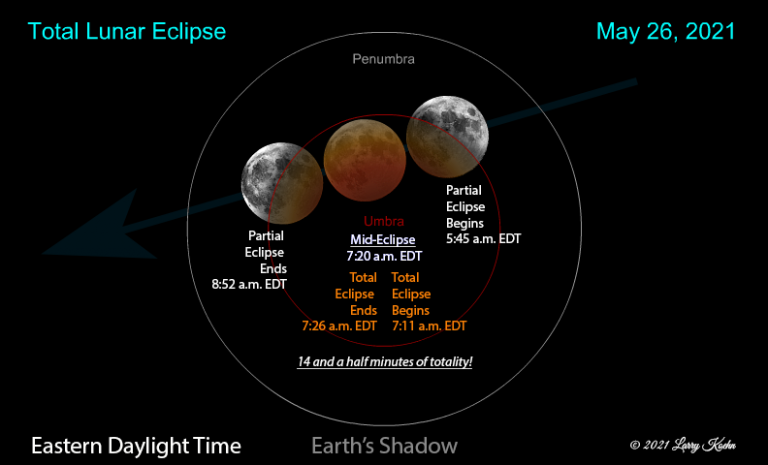
The Total Lunar Eclipse of May 26, 2021, is uniquely positioned at a celestial center point between the Blood Moon Tetrads of 2014-15, and 2025-26. It holds down this singular spot in the heavens, in the center between two Total Solar eclipses on March 20th, 2015 & August 2, 2027, 2259 days on either side of this May 26th, 2021, Total Lunar Eclipse. It is also stationed directly between two other Total Solar Eclipses 1904 days equidistant from this Total Lunar Eclipse, one on March 9th, 2016, and the other on August 12th, 2026. Thirdly, This May 26th, Total Lunar Eclipse also occupies the center point between two other Solar Eclipses, each 694 days on either side of May 26th, 2021, the first on July 12th, 2019, and the second, an Annular Solar Eclipse
on April 20th, 2023. These three sets of Total Solar Eclipses, being separated by accurate day counts, represents one level of precision for the placement of the May 26th Total Lunar Eclipse. It also has a more general position in two cases midway between two Total Solar Eclipses, the first on Dec. 14th, 2020, and the second covered below on Dec. 4th, 2021, both on Hannukah.
This Total Solar eclipse on March 20, 2015, was itself also positioned at the center point between the Blood Moon lunar eclipses of the 2014-15 Tetrad, seen above as the title banner of this month’s blog. The March 20th, Total Solar eclipse [on my birthday], in 2015 occurred a day before the sacred new year began on Nisan 1 (March 21). This eclipse was visible in the sign Pisces, that speaks of the Redeemer’s people consisting of Jews, Gentiles and the spiritual Church of the Body of Christ. Here there was a solar eclipse that occurred 888 days before the Season of Repentance 2017. 888 is the gematria number of our Redeemer’s name in greek– Jesus.
The March 20th Total Solar Eclipse @ the North Pole corresponds to the Portion of the Torah reading in Jewish Synagogues, contained a reference to Nisan 1 and the Dedication of the Tabernacle. An interesting Scriptural element of this story involves a pivotal craftsman of the OT named Bezaleel-whose name means in the “shadow or protection of God.” This provides a direct link with the Shadow of the Total Solar Eclipse at the North Pole, a highly unique event midway in 2014-15 Blood Moon Tetrad on Nisan 1, with key inferences in its purview. Bezaleel was also of the house of Judah [Ex. 31] sharing in the royal line of King David, to Christ, describing how “God had filled him with the Spirit of God in wisdom, in under-standing, in knowledge,” as [Isa. 11:1-10] with the revelation to build the Tabernacle’s holy furniture. Isa. 11:9 tells how the earth [God’s Holy Mount] will be full of the knowledge of the Lord, [Ex. 25, Heb. 8:5] relating to aspects of this eclipse, that was not only seen over the ocean, but whose shadow was always in contact with these waters, symbolizing the earth’s population. [Hab. 2:14]
The Passover Blood Moon on April 4th, 2015 was the third Blood Moon in the Blood Moon Tetrad of 2014-2015, and was the 1st full moon two weeks after the Total Solar Eclipse at the North Pole, on March 20th, Nisan 1, and the Spring Equinox 2015. This marked not only the opening of the ecclesiastical year in Israel, but also the midpoint in both the Hebrew Sabbatical year of 2014-2015, and the Blood Moon Tetrad over the same period. When we consider that there has never been a Total Solar Eclipse at the North Pole in the history of timekeeping in the Hebrew Calendar, we can see that this Passover/Easter Blood Moon was certainly unique. As we consider the Total Solar eclipse on Nisan 1, we should recall that it also coincided with the Dedication of the Tabernacle in the wilderness. But, the April 4th, 2015 Passover Blood Moon, recalled not only, the first Passover of Israel’s Exodus from Egypt, but also the Sabbath Resurrection of the Lord Jesus Christ from the dead. This speaks loudly to the ministry of Jesus Christ designed to fulfill the OT Law, including every aspect of the Passover Lamb’s sacrifice, not only for Israel, but all mankind. With added perspective, we find the revelation of this plan for Moses‘ Tabernacle foreshadowing the blueprints for the Jerusalem Temple, as the ministry of the High Priest after the order of Melchizedek was energized in Christ. [Heb. 8:5]
Who serve unto the example and shadow of heavenly things, as Moses was admonished of God when he was about to make the Tabernacle: for, See said He, that thou make all things according to the pattern shewed to thee in the mount. [Exod. 25]
A total solar eclipse at the North Pole on the Spring Equinox takes place about once every 100 centuries, but has never happened on Nisan 1 in Hebrew Timekeeping, especially when combined with a Supermoon, putting this Total Solar eclipse in a class by itself. The Almighty wants our attention focused on these unique heavenly signs like the Total Solar eclipse at the North Pole, at the center of this Blood Moon Tetrad, linked to the May 26th Total Lunar eclipse also placed midway in these Solar Eclipses! Heb. 8 points out that God was telling Moses in building the Tabernacle and its furniture, that he should stick to the pattern God showed to him, in the mount. It is key that God referred Moses to His Holy Mount Sinai, where He revealed the OT Law to him, mirrored in the earthly version of God’s Heavenly Temple, from the North Pole, the highest point of the physical heavens. [Job 26]
As the high priest after the order of Melchisedek, Jesus inherits his double square breastplate of 12 precious stones, symbolizing the authority of the Lion of the Tribe of Judah as Priest-King over Israel’s 12 [4 x 3] tribes [Ex. 28:15-30]. In keeping with the celestial symbolism theme, the breastplate, was designed with a niche holding the Urim & Thummim, or lights and perfections,
representing the two great lights of the Sun and Moon. As oracles of the High Priest, these two stones revealed the wisdom and glory of the Creator, even as the movements of the Sun and Moon in the heavens declare God’s glory: [Ps. 19:1].
Job 26 provides more detail on this intriguing subject.
Job 26:5-13 5 “The dead tremble, Those under the waters and those inhabiting them.
6 Sheol is naked before Him, And Destruction has no covering.
7 He stretches out the north over empty space; He hangs the earth on nothing.
8 He binds up the water in His thick clouds, Yet the clouds are not broken under it.
9 He covers the face of His throne, And spreads His cloud over it.
10 He drew a circular horizon on the face of the waters, At the boundary of light and darkness. 11 The pillars of heaven tremble, And are astonished at His rebuke.
12 He stirs up the sea with His power, And by His understanding He breaks up the storm.
13 By His spirit He hath garnished the heavens; His hand hath formed the crooked serpent.
In Job Chapters 2-3 we find the record of Job, after Satan had afflicted him, speaking from the depths of his sufferings, he curses his day of birth.
Job 3:4-5, 8-10
4 Let that day be darkness; let not God regard it from above, neither let the light shine upon it. 5 Let darkness and the shadow of death stain it; let a cloud dwell upon it; let the blackness of the day terrify it. 8 May those curse it who curse the day, Those who are ready to arouse Leviathan.9 May the stars of its morning be dark; May it look for light, but have none, And not see the dawning of the day; 10 Because it did not shut up the doors of my mother’s womb, Nor hide sorrow from my eyes.
These verses in Job make some notable connections with the shadow of death. Intriguingly, these links both carry reference to the darkening of daylight, first seen in cloud covering, and second with the blackness of the day which ominously resembles a total Solar eclipse. Here Job links terror to the “blackness of the day,” along with those who arouse Leviathan, [Job 41] who is another manifestation of the serpent as the sea monster. This again identifies the true source of the persecution, disease and death, from the author of death, the Devil and Satan. This imagery speaks loudly to the Biblical symbolism of Eclipses as negative celestial omens, indicative of the enemy’s persecution in the war for mankind in general and Israel specifically, as activity surrounding the Blood Moon Tetrads in history attests. The recurrent theme seen in the Blood Moon Tetrads however, is always deliverance of the Almighty God, Whose Love for His people is ever true and unfailing.
This Solar eclipse imagery is also found at the crucifixion of Christ, as seen in the apparent period of midday darkness on April 28, 28 AD, the day of Jesus’ crucifixion. There is no sign of an eclipse that I have found on this day, but the shadow of death that stained this day was more palpable than any other in history, and the blackness of this day was most evident spiritually in Jesus’ death. This was completely reversed three days later, however when Christ arose as the “first fruits from the dead.” Thus, the brightness of Lucifer’s day of apparent victory was turned into darkness the moment he turned away from the Almighty-the original and eternal Source of Light. We are reminded of this, looking at the April 4th, 2015, Blood Moon in the 2014-15 Blood Moon Tetrad, which took place on both Passover and Resurrection [Easter] weekend.
As the third Blood Moon in this Tetrad, on Passover it commemorates not only the 10th plague of Darkness that consummated the 10 plagues of God’s judgment on Egypt leading to Exodus, but especially God’s protection and deliverance of Israel, which freed them from their Egyptian bondage. This is the dominant theme of the Blood Moon Tetrads, that no matter what persecution the enemy produces, it always works for God’s deliverance, always improving the overall situation of faithful in Israel, and Christians alike.
2. June 10th, 2021, Annular Solar Eclipse between the horns of Taurus the Bull.
Two weeks after the May 26th, 2021 Total Lunar Eclipse, the June 10th, 2021, Annular Solar Eclipse followed. The June 10, 2021, Annular solar eclipse began at sunrise in southern Ontario, Canada. The nearness of these two eclipses occurring back-to- back is called an eclipse season.

The path of this annular solar eclipse touches the North Pole, followed by a total solar eclipse on Dec. 4, 2021 over Antarctica, the first of two polar solar eclipses in 2021, [see #4 below]. Exactly six lunar months (six new moons) after this annular eclipse, another solar eclipse fell on December 4, 2021. Unlike in June 2021, the Dec. 2021 New Moon presented the closest and largest supermoon of the year. The graphic globe below depicts the Annular Solar Eclipse path over the North Pole, extending the polar theme of these eclipse signs.
The path of the June 10th, 2021 Annular Solar Eclipse over the North Pole. 8

3. Nov. 19th, 2021 97% Partial Blood Moon on Kislev 15.
This Partial Lunar Eclipse belongs to Saros 126 and is number 45 of 70 eclipses in the series. All eclipses in this series occur at the Moon’s ascending node. The Moon moved south in respect to the node with each succeeding eclipse in the series. This eclipse occurred at the Moon’s ascending node in Taurus. The Moon was placed near the famous Pleiades; the Seven Sisters – during the eclipse. The Partial lunar eclipse of November 19, 2021, is followed two weeks later by a total solar eclipse on December 4, 2021, also denoting an eclipse season.

The Beaver Moon lunar eclipse started at 1:02 a.m. EST (0602 GMT), and the moon was 97% covered by Earth’s shadow at its peak. The eclipse ended at 6:03 a.m. EST (1203 GMT). [*]
4. Dec. 4th 2021, Total Solar Eclipse in Scorpius, during Hannukah week, 11/28 to 12/6/2021.
The Sun will appear to have a dark shadow on only part of its surface. Viewers in parts of South Africa, Namibia, South Georgia and Falkland Islands, Chile, New Zealand, and Australia will see a partial solar eclipse on Dec. 4.

We referred to a link above with a Blood Moon Tetrad tied to Antiochus IV as a forerunner of the Anti-Christ, due to his desecration of the Jerusalem Temple. This Abomination in God’s Temple demanded that the sanctuary be cleansed by the Israelites, which it was on Kislev 25-at the end of a period of 2300 days [in Daniel’s Prophecy] in 12/16/164 BC; when the Jews instituted the first Hanukkah.
As Rev. Nessle states regarding these 2300 days: “In my analysis of the prophecies of Daniel, I showed that this time span very well could be the entire time span the sanctuary was trodden underfoot by the agents of Antiochus IV. We know in the Book of Maccabees that the end-point of the desecration of the Temple was on Kislev 25, December 13, in 164 BC.”9 This initiated the Hanukkah festival when the Temple was rededicated, due to the desecration of the abomination desolation at the hands of Antiochus IV, as a forerunner of the Anti-Christ.
There was an Annular Solar Eclipse that opened Christmas night to Dec. 26th, 2019 during Hannukah week, which was notable as pointed out by Christian Minister-Pastor Paul Begley, who stated this was the 3rd consecutive year that a solar eclipse appeared during Hannukah.
“Israel has been viewed as the hands of God’s prophetic clock in Matthew 24, and Luke 21:24-33. In these gospel chapters, Jesus used Israel to tell us of a generation that will finally see all the prophecies fulfilled.” When Israel was reborn as a Nation–State in 1948, the “fig tree generation,” was also birthed. As Luke 21:32 says: “This generation shall not pass away, till all be fulfilled.” Jesus confirmed his words when He said, ‘Heaven and earth shall pass away: but my words shall not pass away’ (Luke 21:33). This generation that sees the fig tree shoot forth will not pass till all these things be fulfilled. 10
The 1948 generation is the generation that will not pass till all things prophesied by Jesus in Mathew 24, Mark 13 and Luke 21 be fulfilled. There are faithful who refer to Psalm 90:10 as a determinant of the length of a “Biblical “generation.”
Psalms 90:10: The days of our lives are seventy years; and if by reason of strength they be eighty years, yet is their labor and sorrow; for it is soon cut off, and we fly away.”
According to this position, the following conclusions were drawn. In 2018 this generation was 70 years old the same year that Israel marked 70 years of statehood on May 14th, 1948. But this generation has to attain 80 years for years of “labour and sorrow”- [Great Tribulation], bringing us to the year 2028. So then according to them, from 1948 to 2028= 80 years, then this generation is soon cut off as prophesied in Psalms 90. This “cut off” happens when Christ appears at the Armageddon battle. 11
Therefore, since the ending point of this “fig tree” generation would conclude in 2028, and as Jesus said, ‘this generation shall not pass till all these things be fulfilled,’ they have concluded that means the latest for Jesus Christ to return is in the year 2028.
There are 7 years in the Great Tribulation period (the years of labor and sorrow) that must be fulfilled before the generation is cut off. Since we are already in the year 2022, and a new Shemita cycle starts this September, as Mark Biltz points out, we should be alert.
What I find interesting about this scenario is that 2028 stands out for a few reasons. First, 27-
28 AD is also known as the “acceptable year of the Lord,” the year Christ opened his earthly ministry. The crucifixion date of Jesus Christ was [Nisan 14], April 24th, 28 AD, and his resurrection took place [Nisan 17], May 1st, 28 AD. This makes the year 2028 not only the 2,000 year anniversary of these events, but also wraps up the 6000-year period since Creation.
With the conclusion of this final eclipse of 2021, Earthlings in 2022, will experience four eclipses: two of the sun and two of the moon. The first of these was a solar eclipse, a partial solar eclipse of April 30 involving the 2nd of two new moons in the month of April, what colloquially is known as a “Black Moon.”
5. April 30th, 2022, Partial Solar Eclipse – Nisan 29, 1 week after Passover.
A solar eclipse only occurs at a New Moon phase, when the Sun, Moon and Earth are aligned. If the Moon is new upon landing on the nodal crossing point, a solar eclipse results. Depending on the distances of the Moon to the Earth and the Earth to the Sun, the resulting eclipse will either be total or annular. But in the case of the April 30 solar eclipse, the Moon reached a new phase 23 hours and 26 minutes before reaching the node, which was too far away to allow the moon to pass directly in front of the sun, but still just close enough to allow the moon to cover a part of the sun. 12
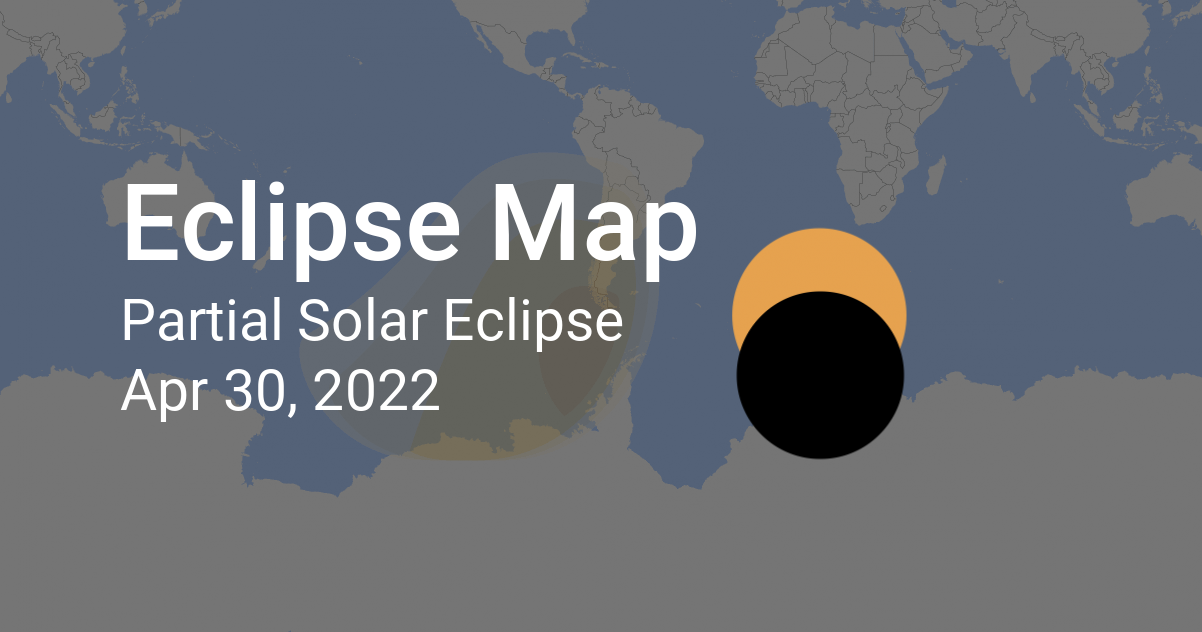
During the eclipse, the Sun is in the constellation Aries. The partial solar eclipse of April 30 was visible from parts of the south-eastern Pacific Ocean and southern South America. It began at 2:45 p.m. EDT (1845 GMT) and ended at 6:37 p.m. EDT (2237 GMT), according to NASA’s solar eclipse page. [*] The partial solar eclipse of April 30, 2022, is followed two weeks later by the Total Lunar eclipse [see below] on May 16, 2022, again denoting an eclipse season. May-Aug. of 2022 also witnessed four consecutive Supermoons.
6. May 16th, 2022 Total Lunar Eclipse on 2nd Passover.
This total lunar eclipse of May 16 was visible across North and South America, Europe and Africa. It began at 9:32 p.m. EDT (0132 GMT) and lasted about 5 hours and 18 minutes, according to NASA’s Eclipse website. The eclipse peaked at 12:12 a.m. EDT (0412 on May 17 GMT). [https://www.space.com/16830-full-moon-calendar.html] The Moon’s location is in the direction of the constellation Libra.

This lunar eclipse takes place 1.5 days before the moon reaches perigee, its closest point to Earth for the month.
So this full moon is a supermoon. The May 16th, 2022 Total Lunar Eclipse took place on the Second Passover, in the 14-15th Iyyar on the Hebrew Calendar, according to the stipulations in Num. 9:4-12 below, given to Moses by the Lord. However, these are considerations of the OT Law, that Jesus fulfilled as the embodiment of the Passover, who covered these transgressions where the Law was concerned.
Num. 9:4-12
4 And Moses spoke unto the children of Israel that they should keep the Passover. 5 And they kept the Passover on the fourteenth day of the first month at evening in the Wilderness of Sinai. According to all that the Lord commanded Moses, so did the children of Israel. 6 And there were certain men who were defiled by the dead body of a man, so that they could not keep the Passover on that day; and they came before Moses and before Aaron on that day. 7 And those men said unto him, “We are defiled by the dead body of a man. Why are we kept back, that we may not offer an offering of the Lord in its appointed season among the children of Israel?” 8 And Moses said unto them, “Stand still, and I will hear what the Lord will command concerning you.” 9 And the Lord spoke unto Moses, saying, 10 “Speak unto the children of Israel, saying: ‘If any man of you or of your posterity shall be unclean by reason of a dead body, or be in a journey afar off, yet he shall keep the Passover unto the Lord. 11 The fourteenth day of the second month at evening they shall keep it, and eat it with unleavened bread and bitter herbs. 12 They shall leave none of it unto the morning, nor break any bone of it. According to all the ordinances of the Passover they shall keep it.
Oct. 8, 2022: The Draconid Meteor Shower.
The Draconid meteor shower which is active Oct. 6-10, is expected to peak on Friday, October 8, and last through October 10, bringing with it a drizzle of meteors for dedicated stargazers, three days after Yom Kippur.
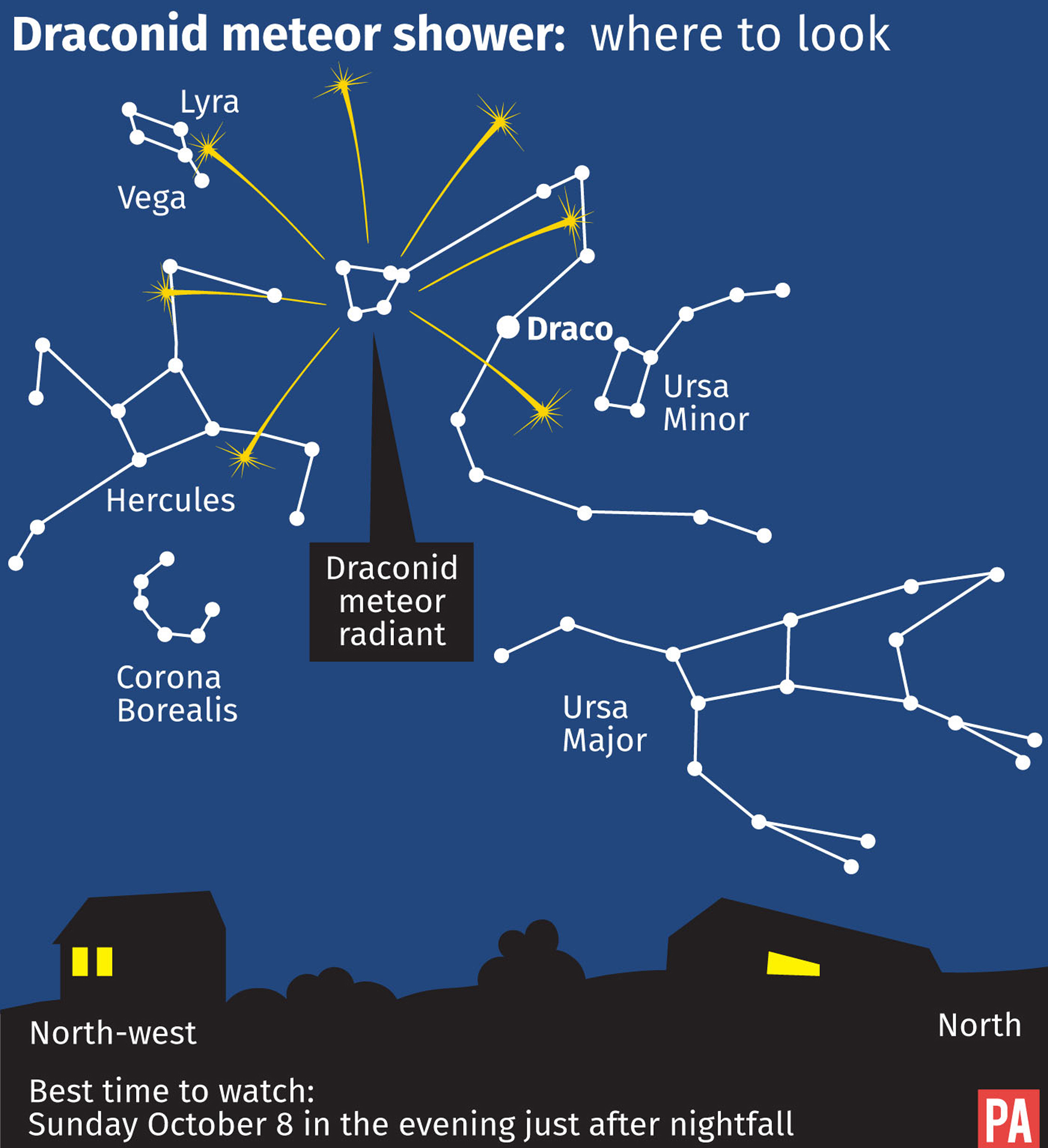
These dates are key historically from October 7th-8th we find 3 Sukkot/Tabernacle Blood Moons in 32 AD, 1949 and 2014, along with a Penumbral lunar eclipse on the Feast of Tabernacles/Sukkot in 70 AD. In 1949 Israel fought for and won their independence as a state, as in 2014 they were fighting Hamas. Both eclipses from October 7th-8th and those falling on October 18th, were all on the Feast of Tabernacles.
7. October 25th, 2022 Partial Solar Eclipse-Tishri 30-Rosh Chodesh Cheshvan

On Oct. 25, the second solar eclipse of 2022 will take place. As in April, this eclipse will be partial, but this time the Moon’s penumbral shadow will fall on the Northern Hemisphere. This partial solar eclipse on Oct. 25 will be visible from parts of Europe, northeast Africa, the Middle East and western Asia. It will begin at 4:58 a.m. EST (0858 GMT) and end at 9:02 a.m. EST (1302 GMT). [*]
8. Nov. 8th, 2022 Total Lunar Eclipse
The total lunar eclipse of Nov. 8 will be visible across Asia, Australia, the Pacific Ocean and the Americas. It will begin at 3:02 a.m. EST (0802 GMT) and last about 5 hours, 53 minutes, with totality lasting 1 hour, 24 minutes, according to NASA. It will peak at 6 a.m. EST (1100 GMT). [*]

The total lunar eclipse of November 8, 2022, is preceded two weeks earlier by a partial solar eclipse on October 25, 2022. These eclipses all take place during a single eclipse season. An eclipse season is an approximate 35-day period during which it’s inevitable for at least 2 (and possibly 3) eclipses to take place.
According to Mark Biltz-this Fall, the Nov. 8th, 2022 Blood Moon could begin the Tribulation week because it opens a new Shemita Cycle, that would pick up where the Crucifixion of Christ left off-at the end of a Shemita cycle in 28 AD. For this reason, if the current Shemita does not start the Tribulation week, it won’t start the Tribulation until the next Shemita Cycle in the fall of 2029-30′, [5790].
This concludes our overview section of the 2021-2022 Luni-Solar Eclipses. I would also like to provide a preview of some of the action for next year. In 2023 we have another April-May eclipse season with a Total Solar Eclipse on April 20, 2023, followed with a Penumbral Lunar Eclipse on May 5-6, 2023. On April 20, 2023, a “hybrid“ eclipse, or an eclipse that starts as an annular, transitions to total, then back to an annular before ending, will be visible from the Indian Ocean, western Australia, New Guinea and the Pacific Ocean. The October-Nov. eclipse season includes an Annular Solar eclipse on Oct. 14, 2023, and a Partial Lunar Eclipse on October 28-29. The Oct.14, 2023, an Annular Solar eclipse will sweep from the Pacific coast of Oregon to the Texas Gulf Coast. This map highlights the paths of the total solar eclipses of 2017 and 2024 and the Annular solar eclipses of 2021 and 2023.
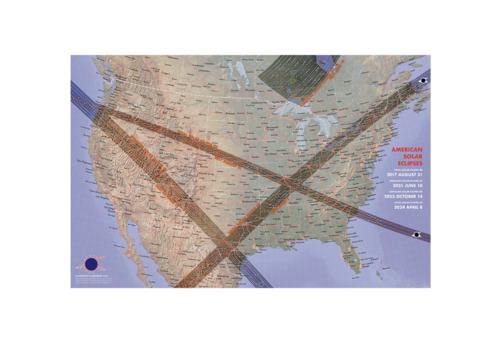
As the Total Lunar Eclipse of May 26, 2021, is uniquely positioned at a celestial center point between two Total Solar Eclipses, each 694 days on either side of May 26th, 2021, the first on July 12th, 2019, and the second Total Solar Eclipse on April 20th, 2023. The Annular Solar eclipse on Oct. 14, 2023 actually serves as the first eclipse that will be crossed over in Texas 6 months later, by the April eclipse in 2024 that also crosses over the path of the 2017 Pan American Eclipse, in the Carbondale area of Illinois. By crossing over the paths of both these eclipses, the message of these three eclipses are linked. The May 26, 2021, Total Lunar Eclipse also holds a general midpoint position midway between the April eclipse in 2024 and the August 2017 Pan American Eclipse, forming an “X” in the midwest of North America.
As we keep our heads to the sky, and our hearts and minds in God’s Word in view of these exciting celestial signs, we anticipate the soon victorious Return of our Lord Jesus Christ to bring us home.
We will see you here, there or in the Air…
God Bless!
Rene’











